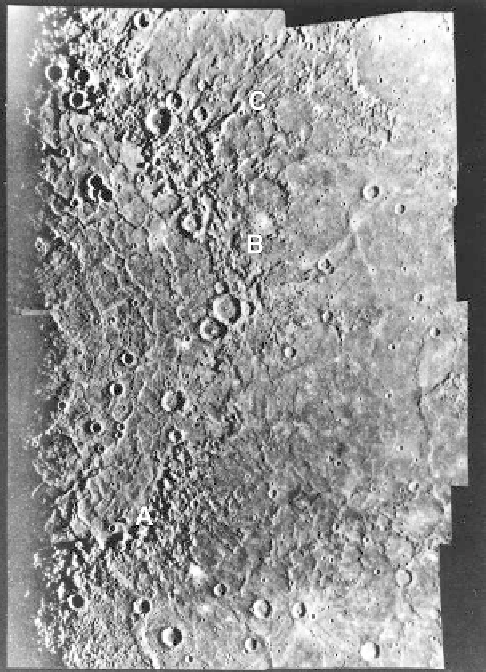Geology Reference
In-Depth Information
lower than about 15°.
Figure 5.18
shows two such impacts
on Mercury, craters Qi Baishi and Hovnatanian, both of
which have asymmetric ejecta patterns.
In many areas, some impact craters display ejecta
deposits that are distinctly darker than the surrounding
plains, suggesting penetration through a bright mantle to
excavate darker underlying materials (
Fig. 5.19
). Like
dark-halo craters on the Moon, these craters on Mercury
might re
ect ma
c volcanic materials thinly mantled with
brighter material, comparable to lunar cryptomaria.
5.5.3 Multi-ring basins
Multi-ring basins are common on Mercury and most pre-
date the intercrater plains deposits. Two of the best pre-
served multi-ring basins are the Caloris and Rembrandt
impact structures. The Caloris basin was discovered and
described from Mariner 10 images, but with less than half
of it being seen (
Fig. 5.20
). Caloris was fully imaged by
MESSENGER (Murchie et al.,
2008
;
Fig. 5.21
), and was
found to have a main ring zone 1,550 km in diameter by as
wide as 250 km. This ring zone includes massifs that stand
1
Figure 5.19. An oblique view of Nawahi crater (34 km in diameter)
on the
floor of the Caloris basin. Its dark ejecta deposit suggests an
impact through a thin mantle of relatively bright materials to
excavate darker materials from the subsurface (NASA MESSENGER
NAC 108826682).
2 km above the surrounding plains. The massifs are
considered to be blocks of crust uplifted by the impact
and are de
ned as the Caloris Montes Formation
(
Fig. 5.22
). Plains units are found among the massifs
and are thought to be fall-back ejecta, and perhaps melt
deposits, from the impact that formed the basin. Radially
-
Figure 5.21 Amosaic of the Caloris basin using Mariner 10 images on
the east (right) side that were taken under low Sun-angle
illumination and MESSENGER images (left) under near full-Sun
illumination. The inner dashed circle shows the basin diameter
inferred from the Mariner 10 data, while the larger dashed circle
shows the main ring diameter of 1,550 km derived from the more
complete data. The arrow marks
Figure 5.20. A mosaic of Mariner 10 images showing the eastern
part of the Caloris basin with its prominent ring named the Caloris
Montes (A), the Odin Formation. (B), the Van Eyck Formation. (C),
and the plains that
ll the basin
oor to the left (NASA Jet Propulsion
Laboratory).
of
cially named
Pantheon Fossae, shown in
Fig. 5.25
(NASA MESSENGER images).
“
the spider,
”





